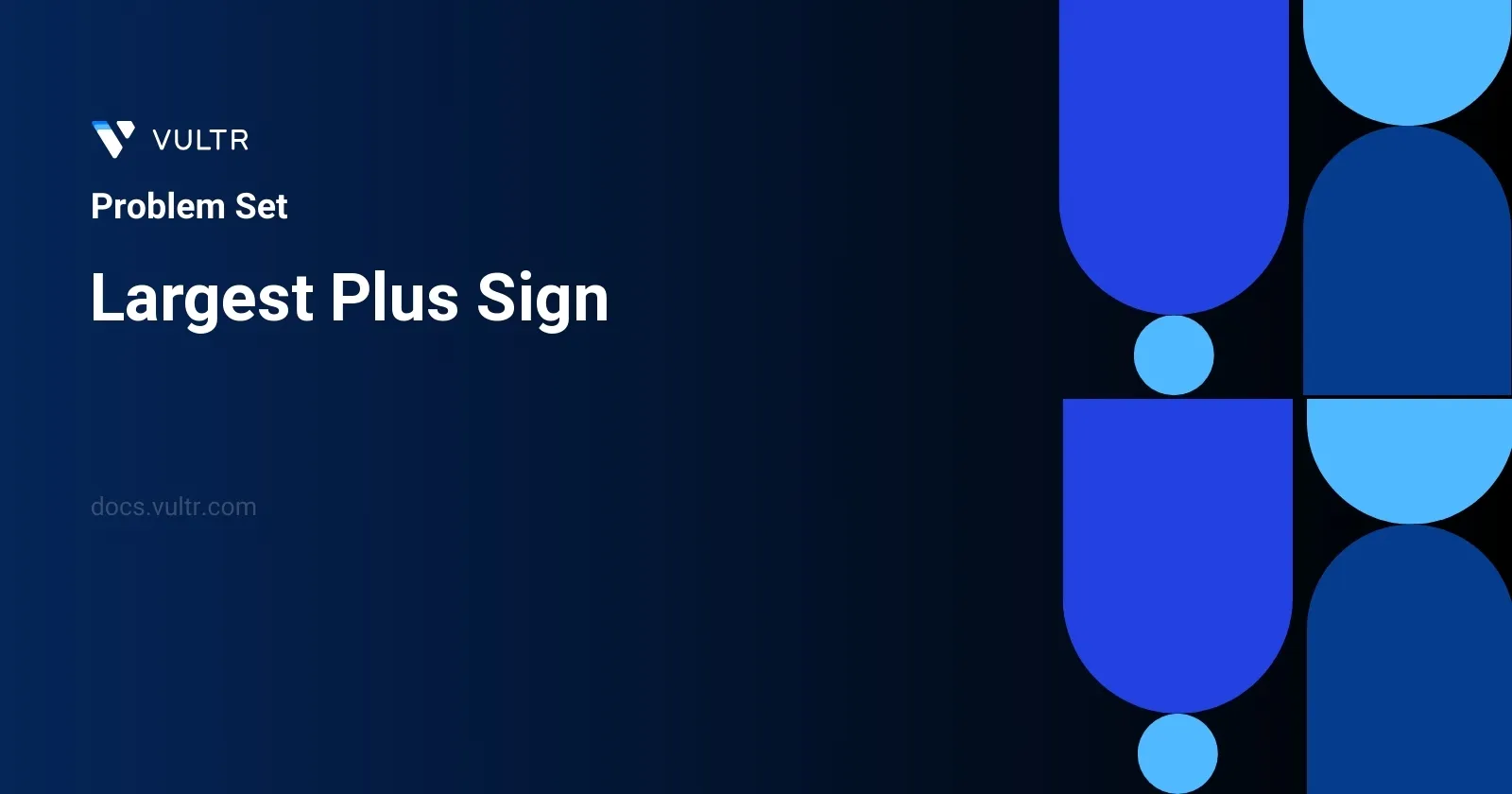
Problem Statement
In this scenario, we are provided with an integer n which defines the dimensions of an n x n binary grid where each cell initially contains the value 1. We are also given an array mines, where each element represents coordinates in the grid that should be set to 0. The coordinates are provided in the format [xi, yi], meaning the value at grid position (xi, yi) needs to be changed to 0.
Our task is to determine the order of the largest "axis-aligned" plus sign made up entirely out of 1s that can be formed within this grid. The order of a plus sign, denoted as k, indicates a center with a value of 1 (grid[r][c] == 1) and four arms extending from the center, each of length k-1. The arms extend upwards, downwards, to the left, and to the right. If no plus sign can be formed, the function should return 0.
Examples
Example 1
Input:
n = 5, mines = [[4,2]]
Output:
2
Explanation:
In the above grid, the largest plus sign can only be of order 2. One of them is shown.
Example 2
Input:
n = 1, mines = [[0,0]]
Output:
0
Explanation:
There is no plus sign, so return 0.
Constraints
1 <= n <= 5001 <= mines.length <= 50000 <= xi, yi < n- All the pairs
(xi, yi)are unique.
Approach and Intuition
The task involves forming the largest possible plus sign in a given grid with potential obstacles (indicated by 0s). Here's the step-by-step reasoning for solving the problem:
Initial Setup:
- Construct the grid with default values of
1. Use themineslist to set specific coordinates to0.
- Construct the grid with default values of
Compute Arm Lengths:
- For each cell in the grid that contains a
1, compute the maximum possible length of arms extending in each direction (up, down, left, right) while avoiding0s. - This can be done by scanning each row and each column in both directions:
- Calculate and store consecutive
1s distance for every cell for each direction.
- Calculate and store consecutive
- For each cell in the grid that contains a
Calculate Largest Order:
- For each potential center (
1in the grid), determine the minimal arm length from the four calculated directions. This will ensure that a plus can actually be formed. - The smallest of these four lengths determines the largest possible order
kfor the plus sign centered at that cell.
- For each potential center (
Record the Maximum Found:
- As you compute the possible plus sign for each center, keep track of the largest value of
kfound throughout the entire grid.
- As you compute the possible plus sign for each center, keep track of the largest value of
Edge Cases and Constraints Handling:
- If
nis1and it has a mine, the largest order is immediately0. - Given the constraints where
ncan go up to500and up to5000mines, efficient calculation and storage of potential arm lengths for each cell is necessary for performance.
- If
By employing this methodical approach, we ensure that we traverse each cell optimally and calculate the maximum order of the plus sign, keeping in mind obstructions due to zeroes introduced by the mines.
Solutions
- Java
class Solution {
public int largestPlusSign(int size, int[][] mines) {
Set<Integer> blocked = new HashSet();
int[][] grid = new int[size][size];
for (int[] mine: mines)
blocked.add(mine[0] * size + mine[1]);
int result = 0, span;
for (int row = 0; row < size; ++row) {
span = 0;
for (int col = 0; col < size; ++col) {
span = blocked.contains(row * size + col) ? 0 : span + 1;
grid[row][col] = span;
}
span = 0;
for (int col = size - 1; col >= 0; --col) {
span = blocked.contains(row * size + col) ? 0 : span + 1;
grid[row][col] = Math.min(grid[row][col], span);
}
}
for (int col = 0; col < size; ++col) {
span = 0;
for (int row = 0; row < size; ++row) {
span = blocked.contains(row * size + col) ? 0 : span + 1;
grid[row][col] = Math.min(grid[row][col], span);
}
span = 0;
for (int row = size - 1; row >= 0; --row) {
span = blocked.contains(row * size + col) ? 0 : span + 1;
grid[row][col] = Math.min(grid[row][col], span);
result = Math.max(result, grid[row][col]);
}
}
return result;
}
}
In the provided Java program, the task is to determine the size of the largest 'plus sign' that can be formed on a size x size grid with specified cells (mines) blocked.
- The solution utilizes a
HashSetcalledblockedto efficiently check if a cell is blocked. - A 2D array,
grid, is initialized to represent the grid where the largest possible spans of unblocked cells are calculated.
The solution follows these steps:
Convert each mine's position from 2D to 1D and add to the
blockedset.For every row in the grid:
- For left to right, calculate the continuous number of unblocked cells (
span) and store ingrid. - For right to left, update
gridwith the minimum value between the current and newly calculated continuous spans.
- For left to right, calculate the continuous number of unblocked cells (
For every column:
- For top to bottom, calculate spans similar to the row processing step and update
gridaccordingly. - For bottom to top, repeat the process and track the maximum span found during the updates.
- For top to bottom, calculate spans similar to the row processing step and update
The maximum value found in grid after processing is the size of the largest possible 'plus sign'. This result is returned at the end of the function. This approach ensures a comprehensive check along both dimensions and accounts for obstacles effectively. The use of Math.min and Math.max aids in continuously updating the smallest and largest possible spans while iterating through rows and columns backwards and forwards respectively.